The St. Andrews links trust provides a multitude of interesting facts, hole guides, routing and history information of the Castle Course at the following link:
http://www.standrews.org.uk/golf/the_courses/course_no7.htmlTo supplement their offerings, I submit this collection of my personal images and commentary.
Enjoy.
FYI: My other pictorial threads from this trip can be viewed at the following links:
Royal Dornoch
http://golfclubatlas.com/forum/index.php/topic,40107.0/Brora
http://golfclubatlas.com/forum/index.php/topic,40120.0/ Golspie
http://golfclubatlas.com/forum/index.php/topic,40126.0/ The Castle Course
http://golfclubatlas.com/forum/index.php/topic,40204.0/ Murcar
http://golfclubatlas.com/forum/index.php/topic,40281.0/Crail: Craigshead & Balcombie
http://golfclubatlas.com/forum/index.php/topic,40325.0/Lundin Links
http://golfclubatlas.com/forum/index.php/topic,40387.0/Muirfield
http://golfclubatlas.com/forum/index.php/topic,40439.0/Cruden Bay
http://golfclubatlas.com/forum/index.php/topic,40565.0/Gleneagles - Kings Course
http://golfclubatlas.com/forum/index.php/topic,40675.0/St. Andrews - Old Course
http://golfclubatlas.com/forum/index.php/topic,40696.0/Gullane #1 & #2
http://golfclubatlas.com/forum/index.php/topic,41085.0/Panmure
http://golfclubatlas.com/forum/index.php/topic,41122.0/Gleneagles - Queens Course
http://golfclubatlas.com/forum/index.php/topic,41152.0/Kingsbarns
http://golfclubatlas.com/forum/index.php/topic,41184.0/Royal Aberdeen - Balgownie Links
http://golfclubatlas.com/forum/index.php/topic,41498.0/Carnoustie – Championship Course
http://golfclubatlas.com/forum/index.php/topic,41834.0/North Berwick - West Links
http://golfclubatlas.com/forum/index.php/topic,42104.0/*not featured: Nairn, Eden, New, Castle Stuart (tour)
Practice grounds provide a suitable place for players to patiently await their turn at the first tee. The landscape no longer reflects the flat, agricultural state of a few years ago. Great care was clearly taken to ensure that the tee boxes blend seamlessly with their surrounds.
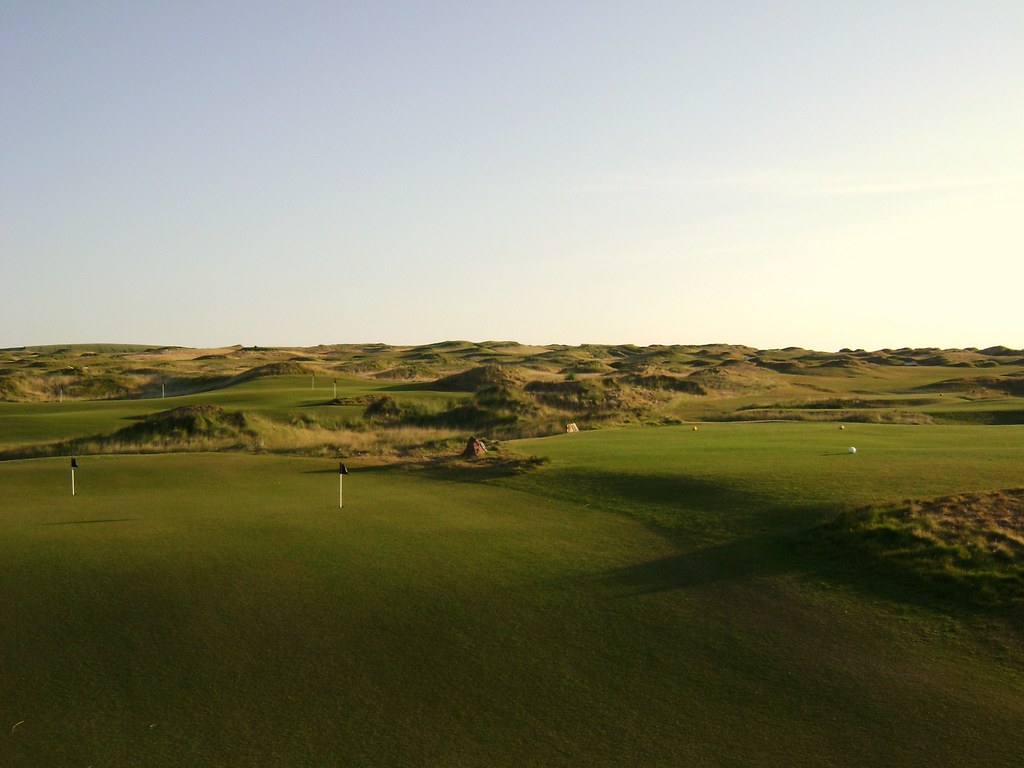
The first tee shot. Par 4. 346 yards.
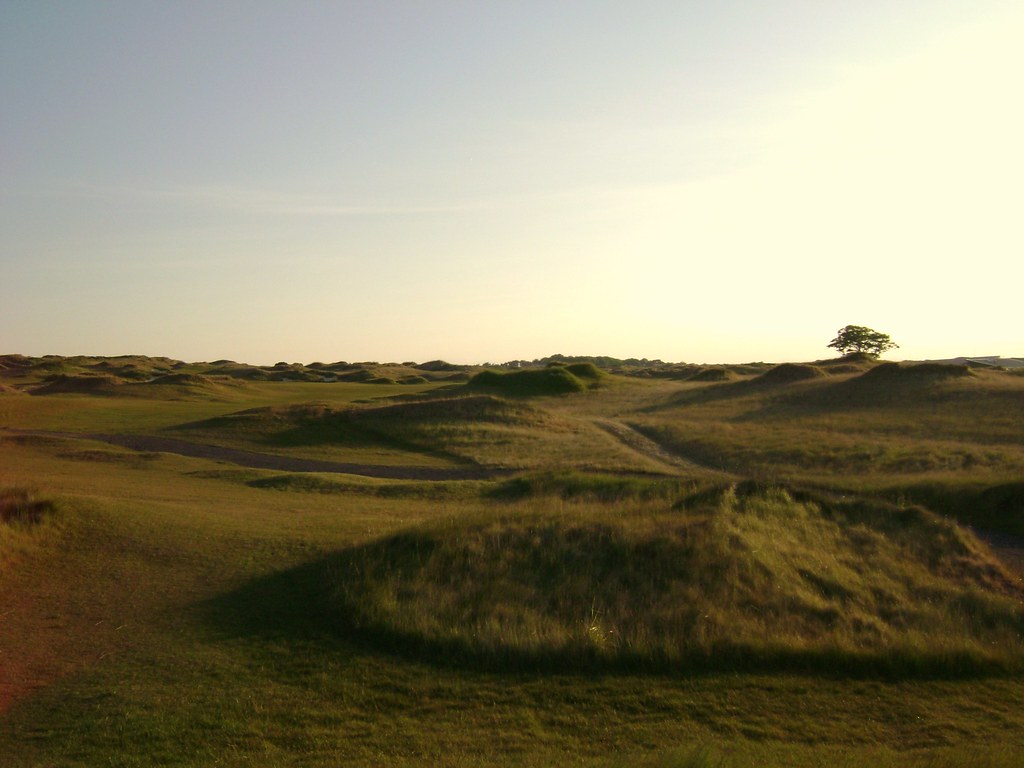
The landing zone for the first tee shot presents a safe play is towards the bunkers on the left (266 yards out), The mounding seen just right of the bunkers is only 233 yards from the tee such that better players hoping to attack the right channel will think twice about hitting driver, thus the smart play is to lay up on the left side of the fairway (the architect intends to steer play away from the entry road right of the fairway. More mounding obscures the view of the green from the right, but is well short of the surface.
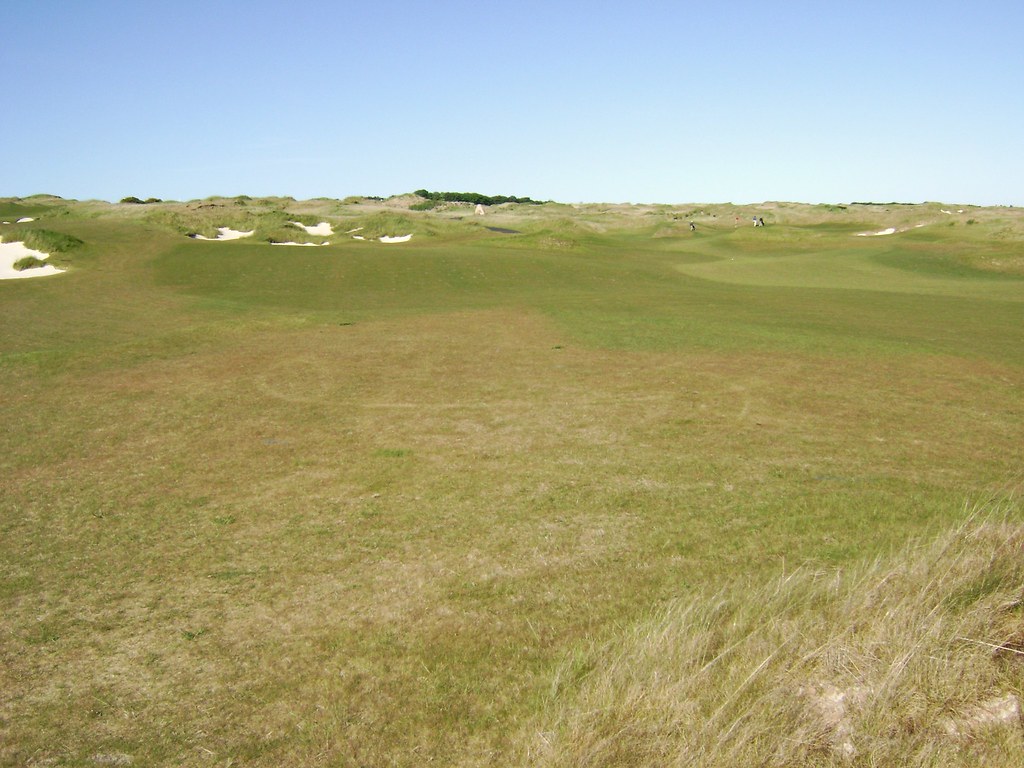
Looking back from the left/rear corner of the green. The controversial “centerline” mounds are quite apparent.

My take on the middling middle mounds:
+Tie in with shaping of surrounds, create strategy, are well-displayed in yardage guide, are kept well-trimmed now that grasses have established
-Penalize balls that end up slightly offline on a windy site, especially galling when placed in blind landing areas (not a huge problem for frequent players or those that study yardage guide)
Landing zone on 404 yard, dogleg right par 4. 253 yards to carry the bunkers inside the dogleg, 299 yards into the left side bunkers.
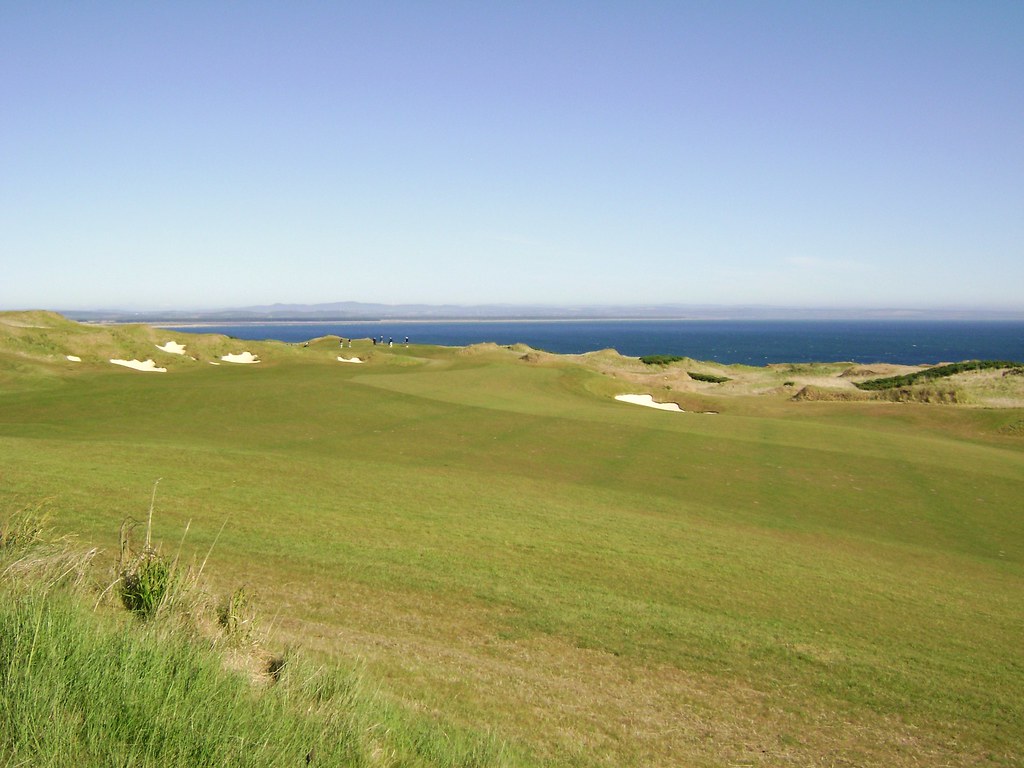
202 yard par 3 3rd. That pin placement is of the “sucker” variety, on a small shelf at the left edge of the green. The greens are all a bit over shaped, in my humble opinion, with the 14th taken to the greatest extremes. The general concept of the surfaces are sound, just t pushed about 10% past what I think would achieve MacKenzie’s ideal of providing the greatest pleasure to the greatest number of golfers. Even short putts break tremendously. I’d hate to play them at a stimp reading above 9, with winds any stronger than the ones I faced (15mph), or with soggy fairways that required aerial approaches to firm greens. Thankfully, the fairways played firmly and the greens at mild speeds. It would be very easy for the course to be made unplayable when maintenance practices fail to strike this delicate balance.
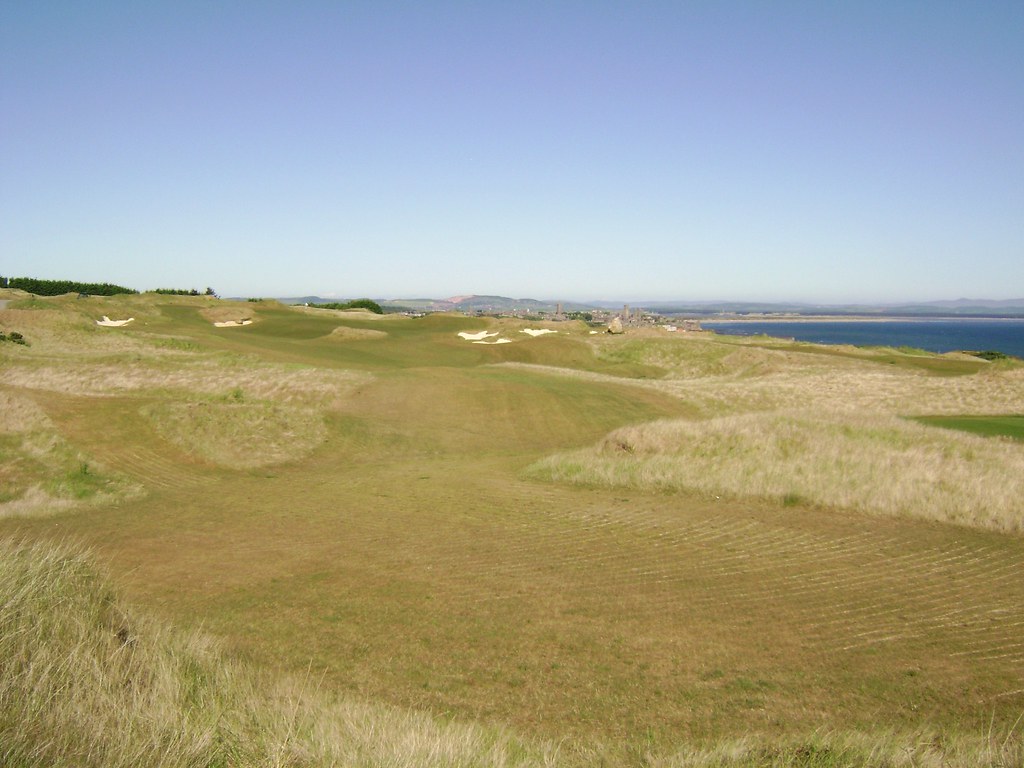
The 3rd green viewed from the left. That bunker guarding the front/left corner of the green is very penal. Playing downwind, I landed my shot just short of the green on a steep up slope, running the ball 20 feet past the flag on the sucker tier. This close up of the mounding shows how short the scrub grasses are kept near the centerlines.
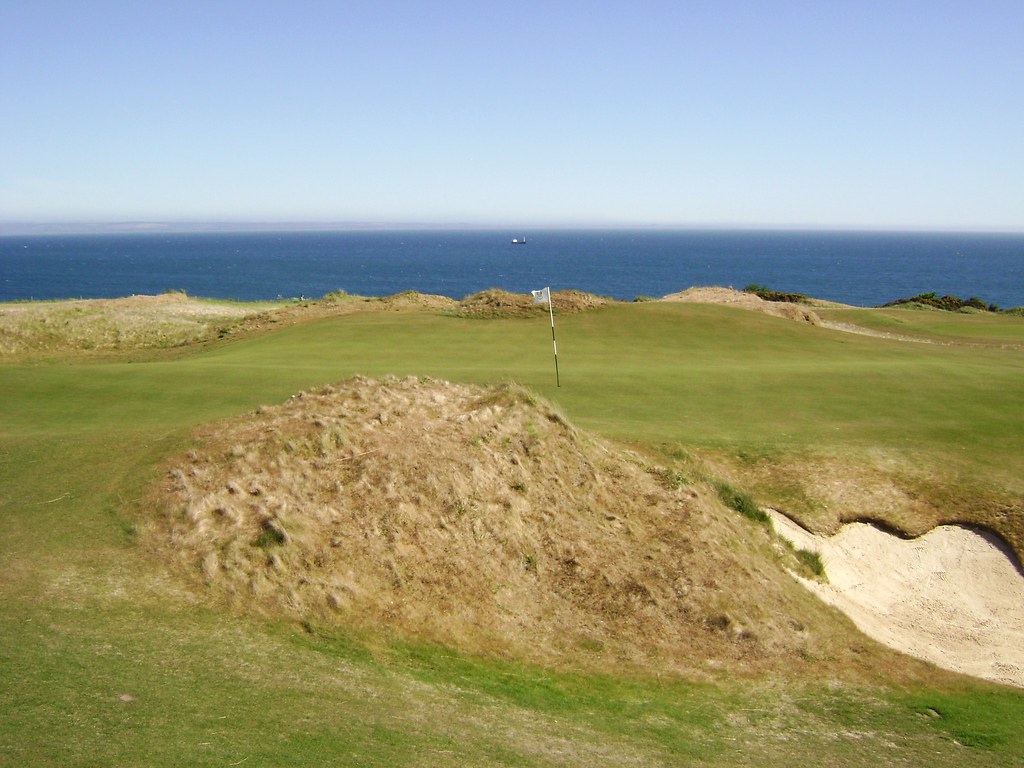
The 4th hole is a 540 yard par 5 that doglegs left up a steady grade. A burn wanders across the fairway around 75 yards from the massive green. The putting surface is in the shape of a 3-leaf clover. This view is from the right side of the green, looking at the high middle tier, with the lower front tier out of frame left.

The 5th hole is a 536 yard par 5 headed opposite to the 4th (a good routing choice for a windy site).
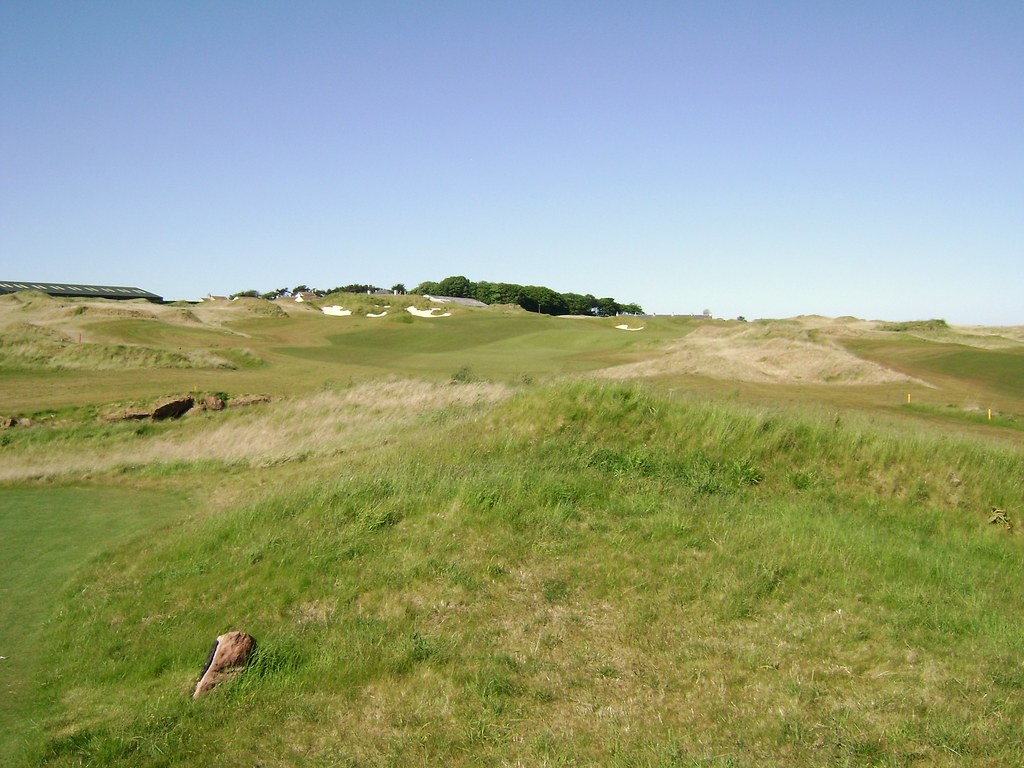
Further along, the fairway is interrupted by an oblong centerline mound 166 yards from the green before wrapping around the left side of bunkers at 106 yards out. Aggressive second shots can be played over the bunkers…

… and receive a healthy kick forward off of a down slope through a gap to the green.
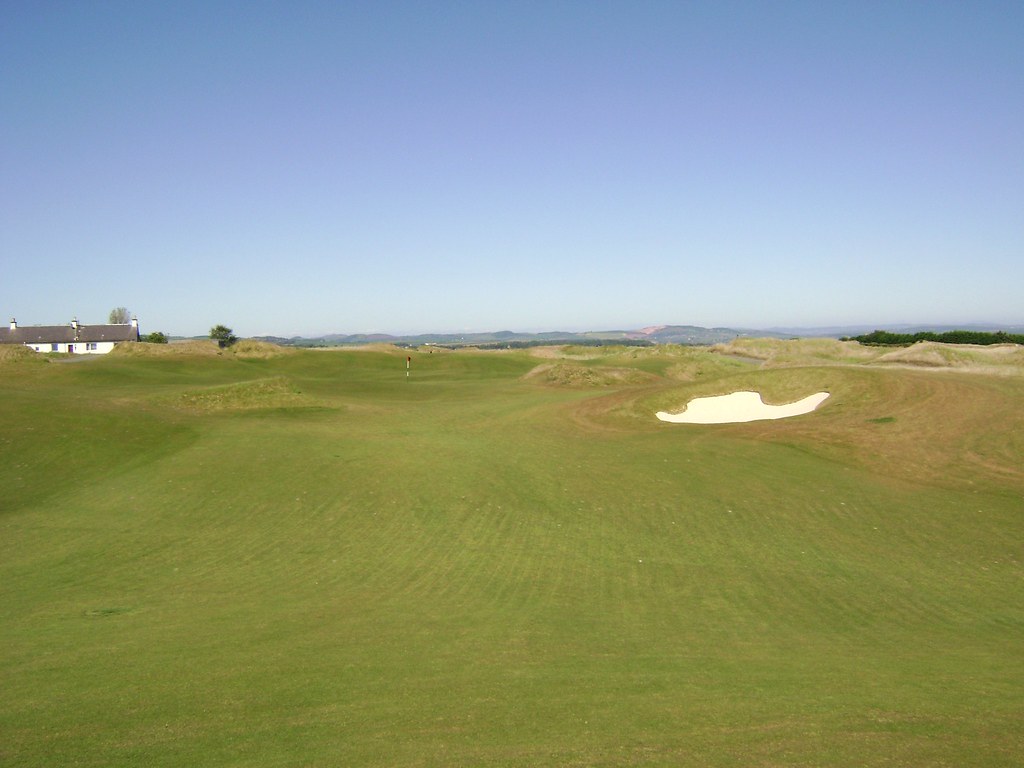
The 412 yard 6th hole takes the course from the northwest corner to the northeast corner of the property. After a blind drive over the brow…
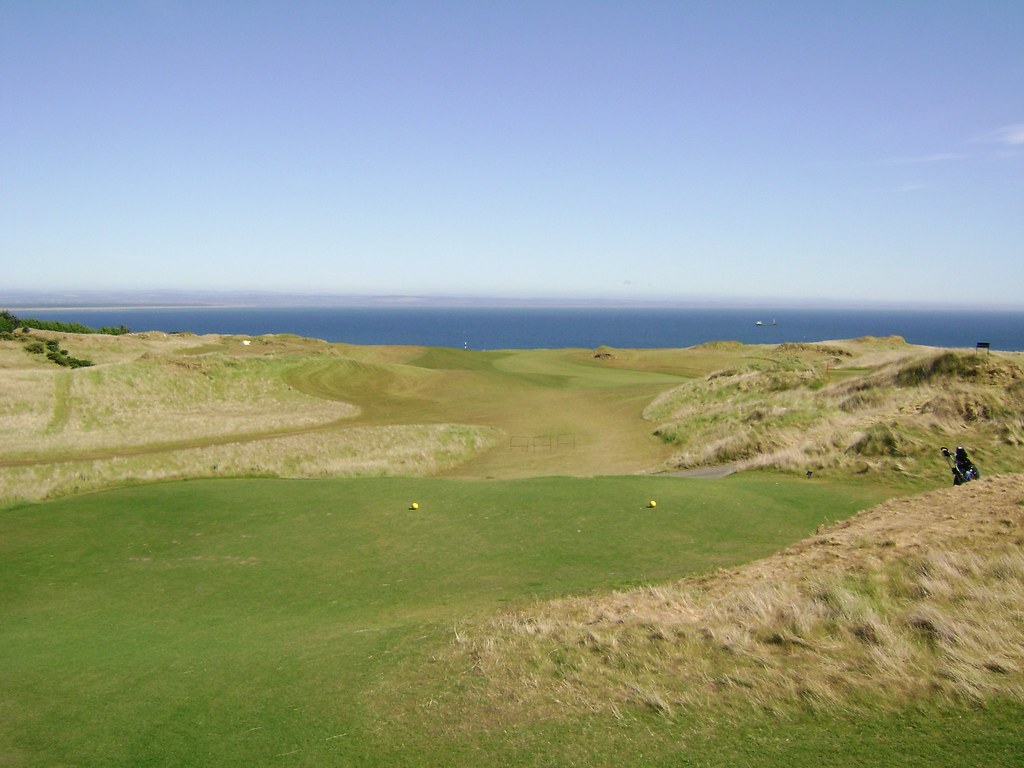
…the approach plays heavily downhill to a horizon green with trouble behind.
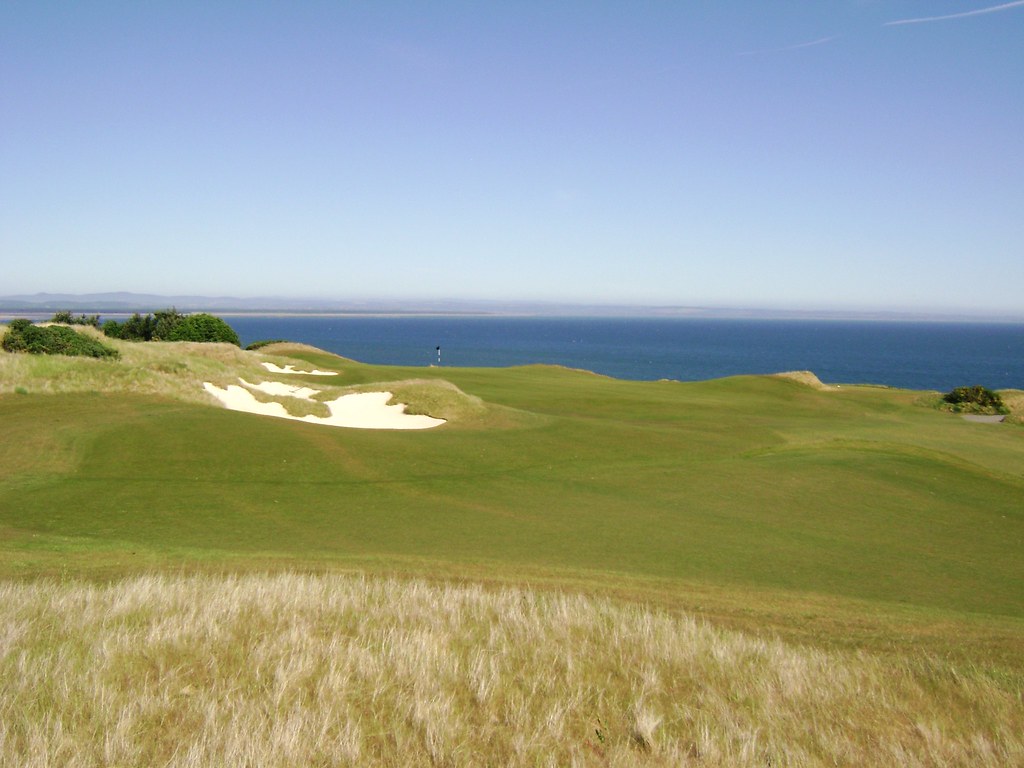
Trouble behind the green doubles as the foreground in stunning views of the town of St. Andrews and the East Sands.
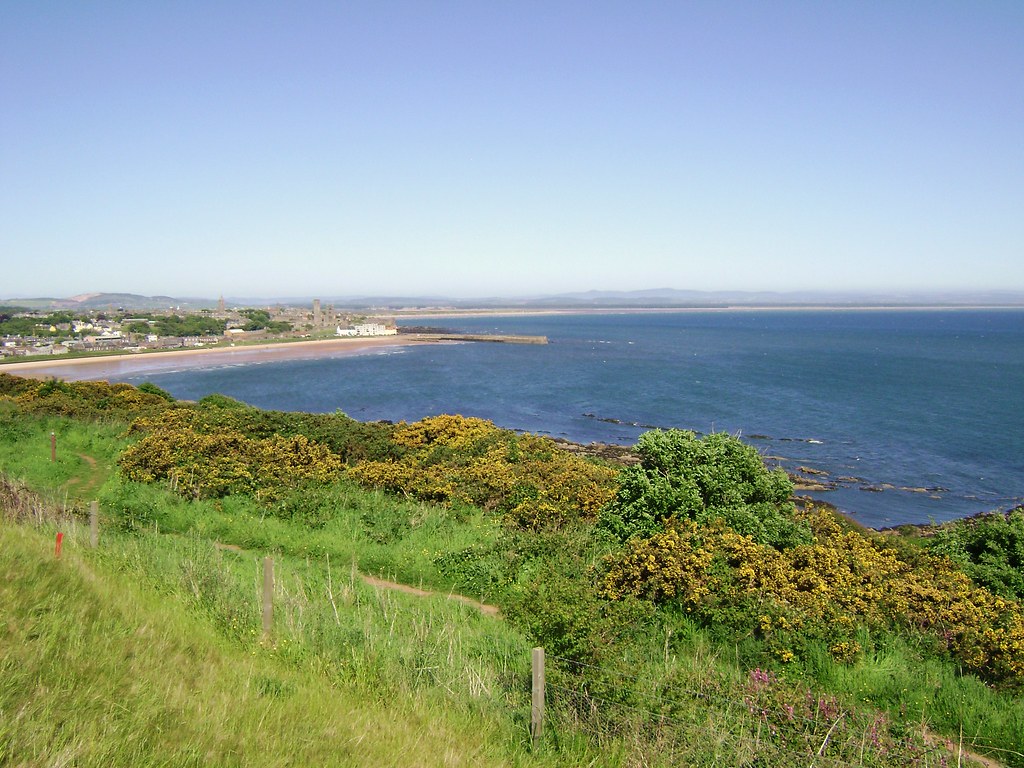
At a brawny 456 yards, the 7th plays very tough when winds are unfavorable
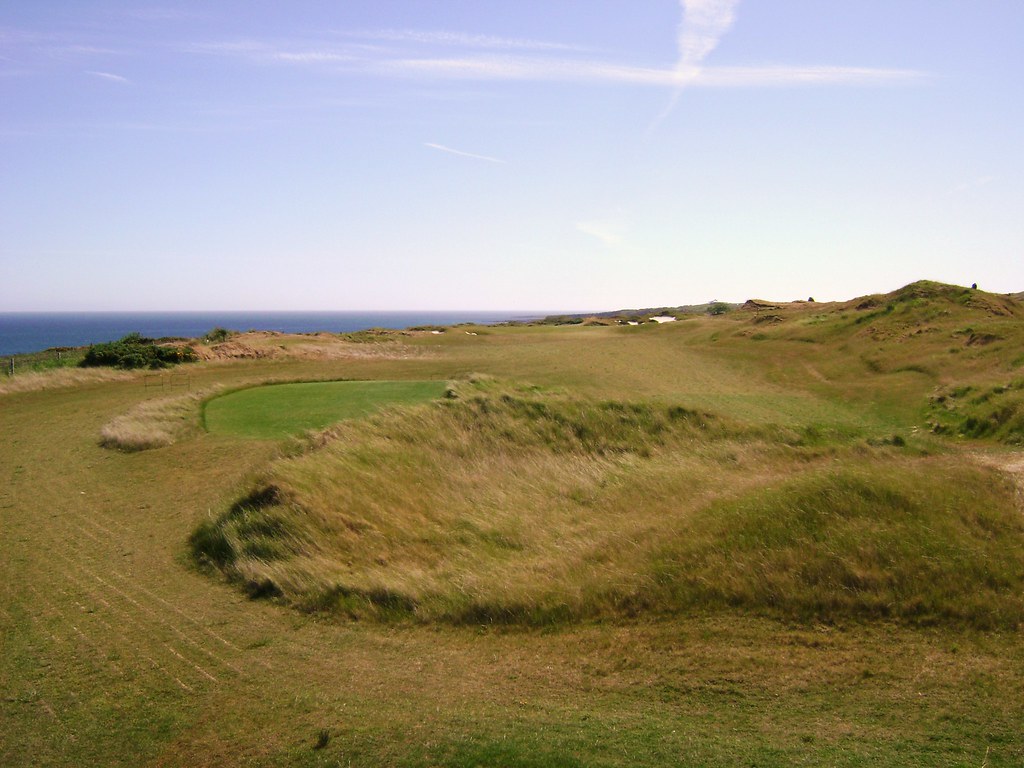
The 7th fairway slopes and doglegs from right to left as it descends.
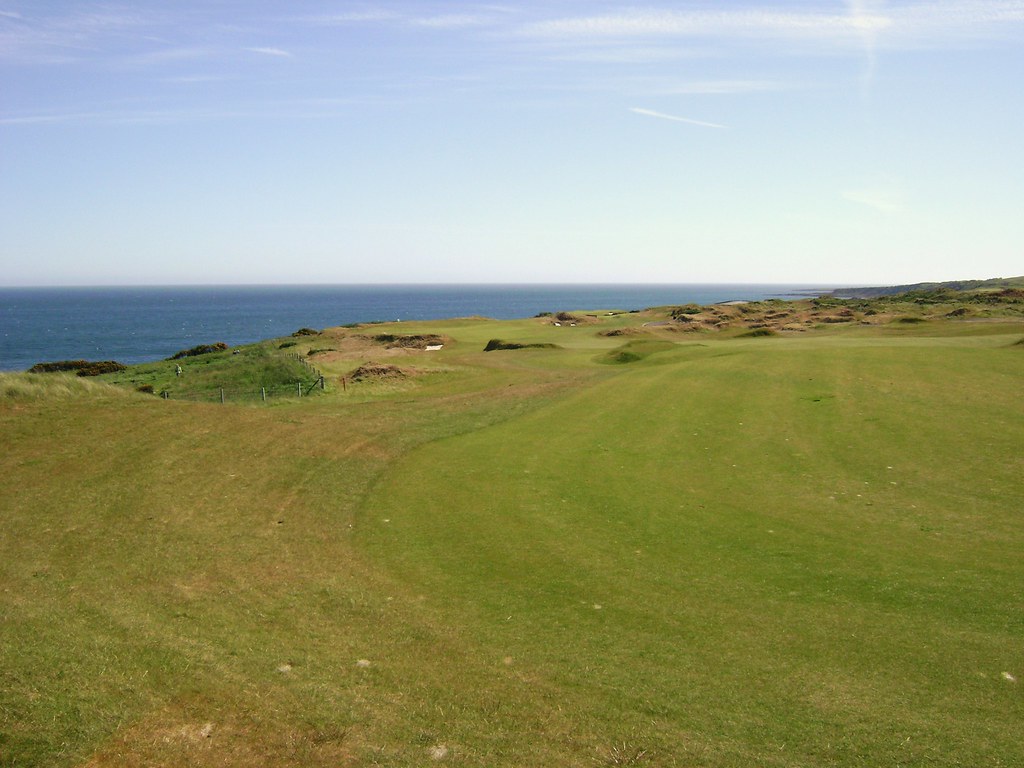
As seen, the 7th green plays hard against the cliffs and is protected short/left (also long/right, out of frame) by bunkers.
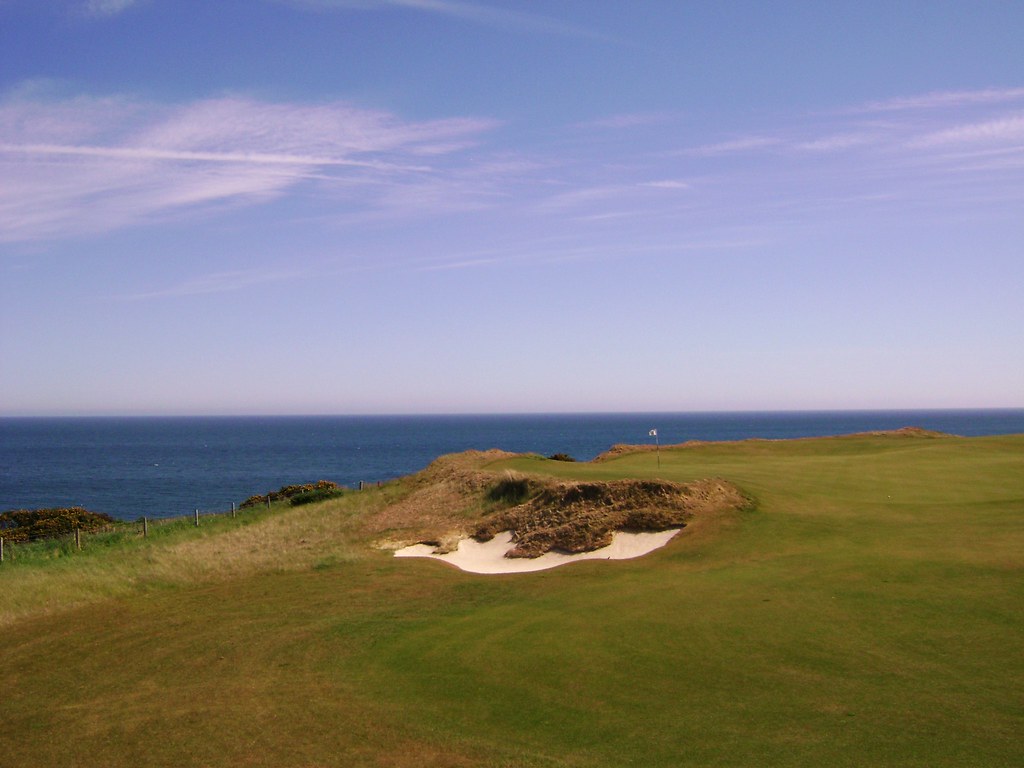
The 8th plays up to 141 yards long, with a large green and another sucker pin presented on this day at the right/rear. The St. Andrews water treatment plant is carefully hidden behind earthworks behind the right side of the 8th. The low-profile clubhouse sits beyond the 9th tee.
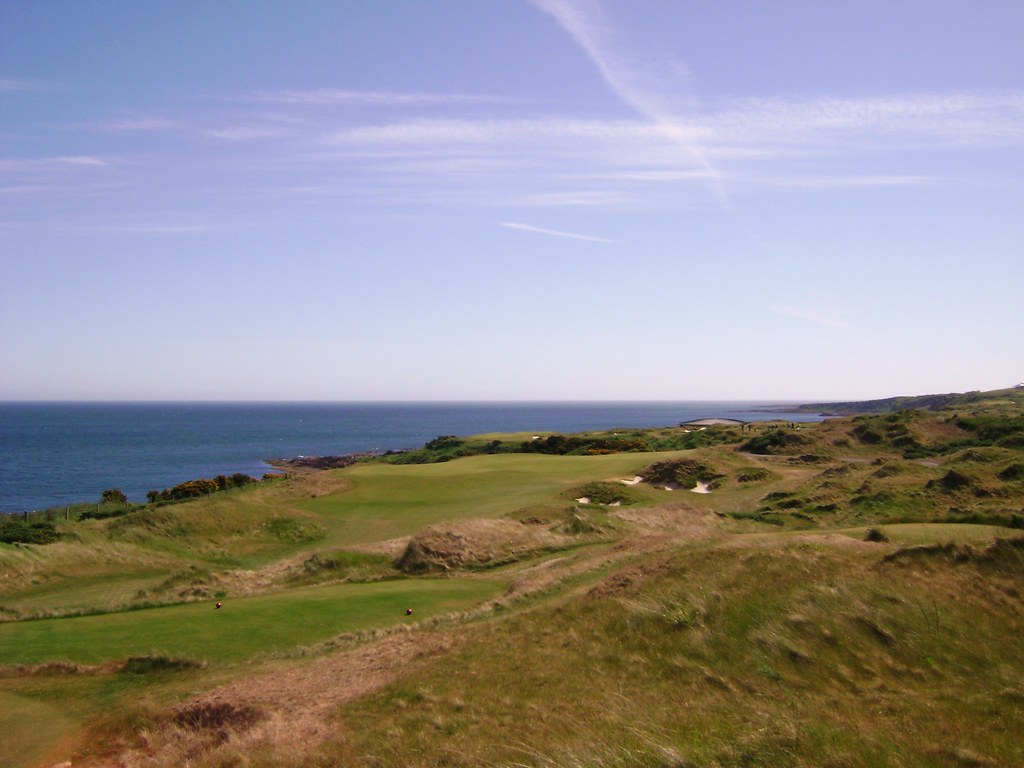
The 381-yard 9th plays downhill to a shared green (with the 18th pin on the far side of Kinkell Point).
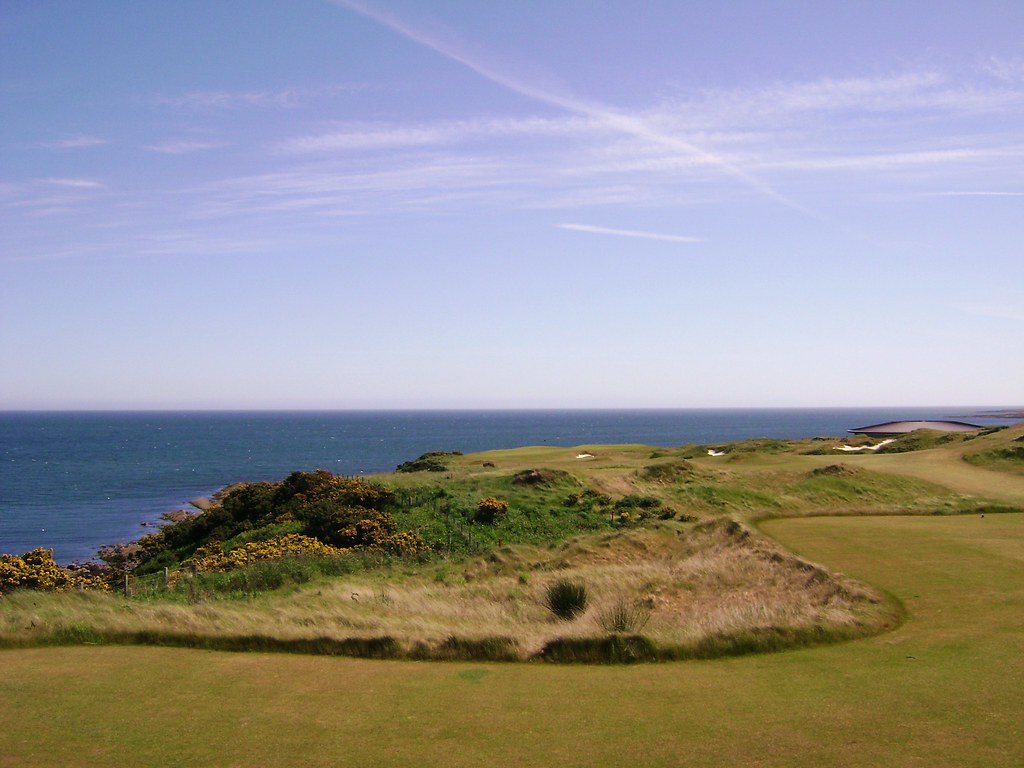
Bunkers capture cowardly tee shots shots that shy away from the cliffs while the green itself is protected by a single bunker and surrounding fall-offs.
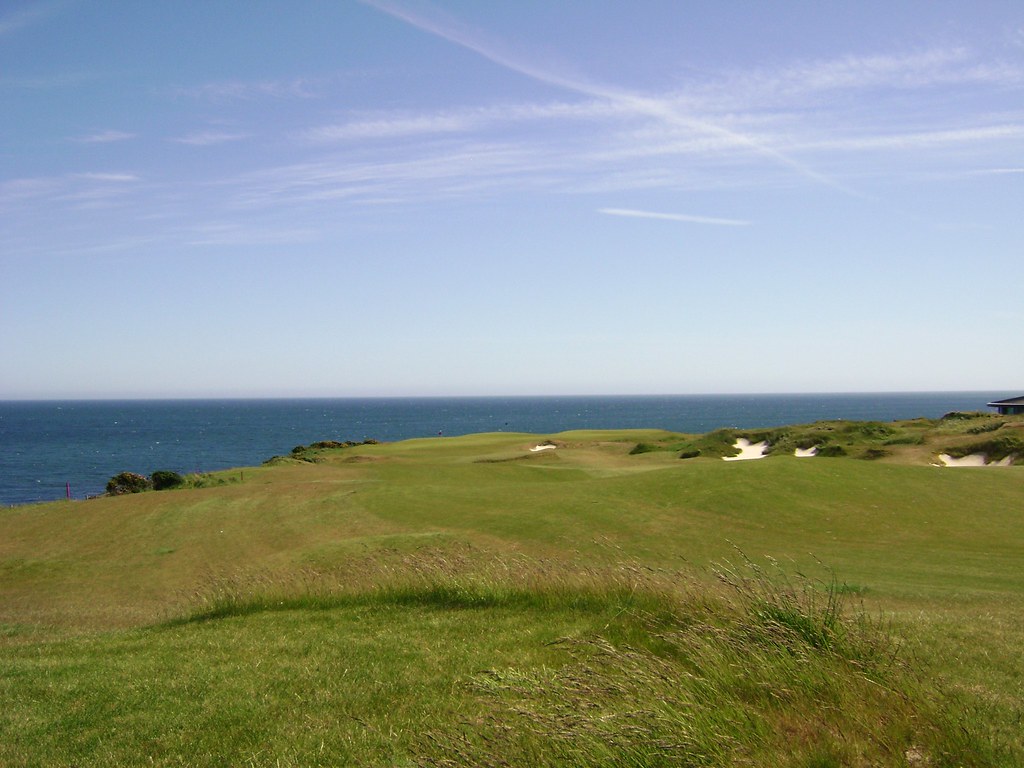
Playing slightly uphill, the 10th is 167 yards long with a burn running down the left side and a centerline mound guarding the front of the green.
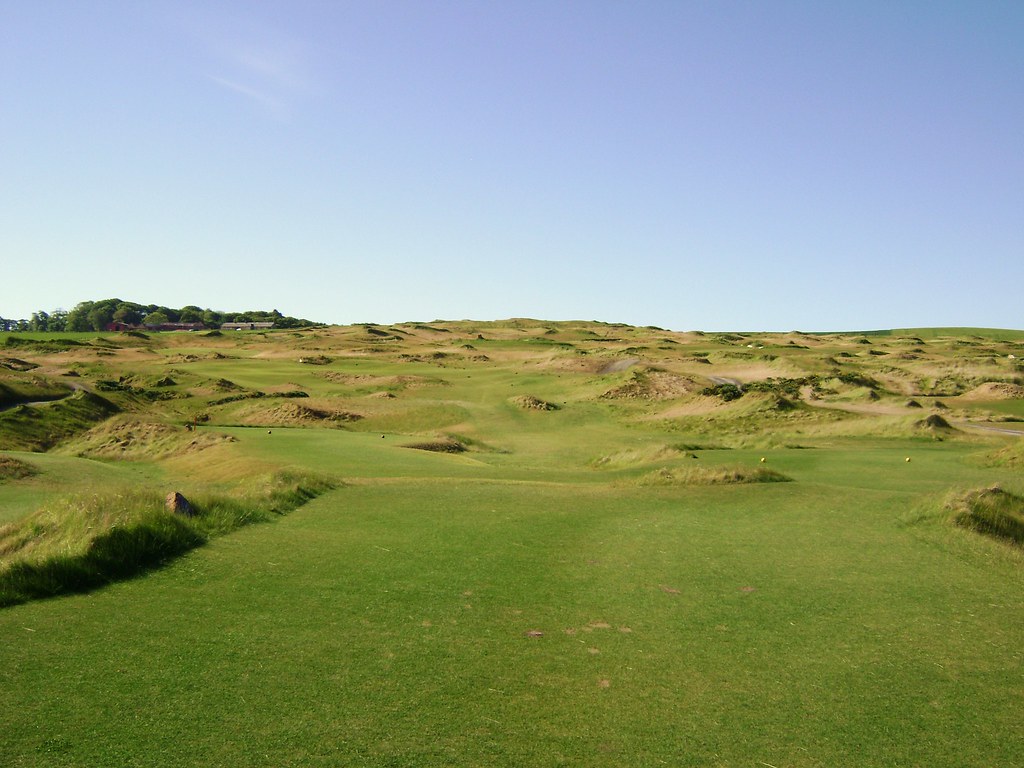
From the left/front of the green, one can see how the centerline mound artfully flows into the putting contours. This day’s pin location sits in a large depression that extends two thirds of the way into the green.
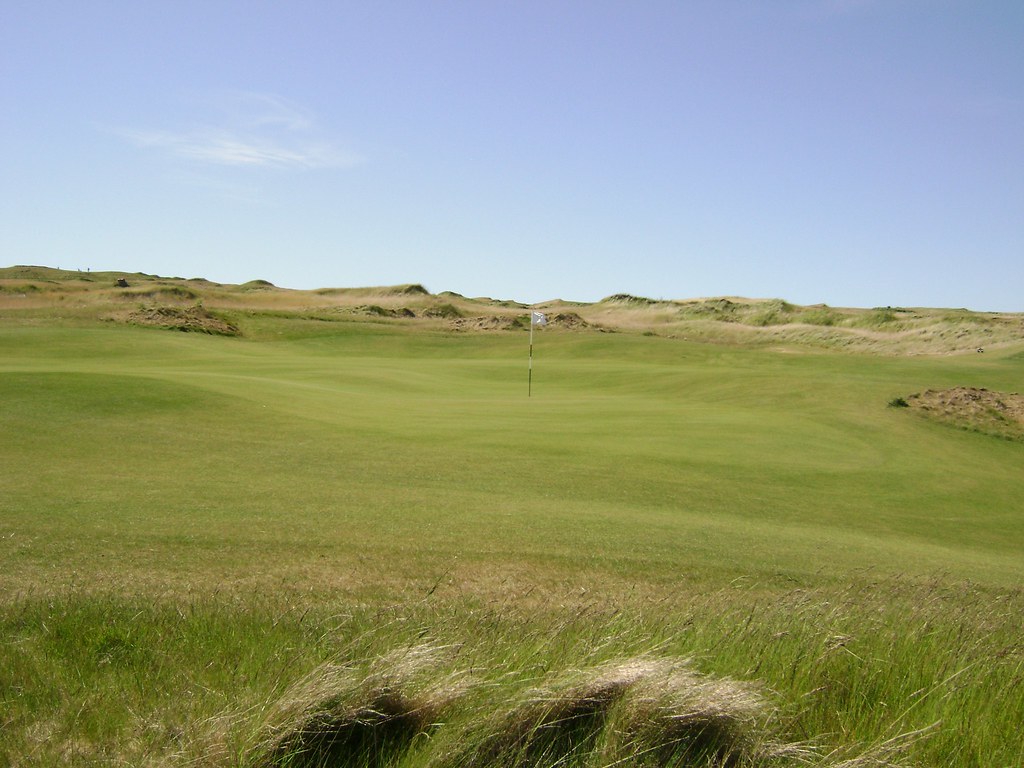
The 11th hole plays 402 yards uphill on the left flank of the 1st.
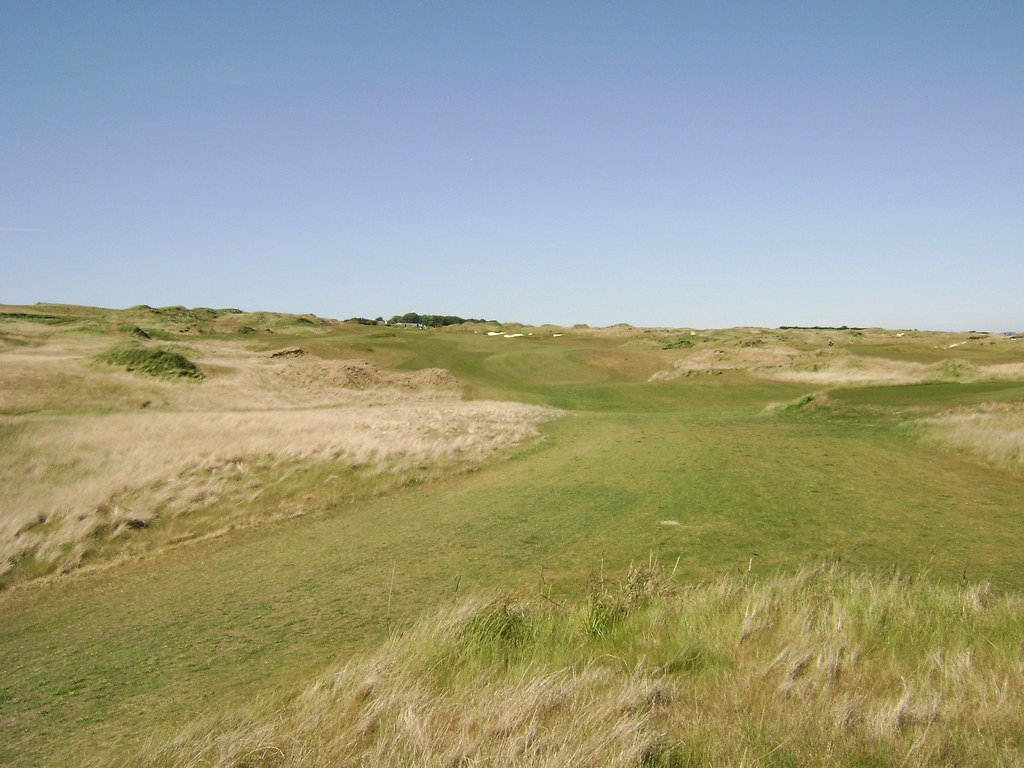
From the right side of the fairway, the right side of the green is hidden, as is a large swale beyond the far right side bunkers (which are well short). The pin is on the horizon between the trees and mound. Long/left is a safe miss, as the green surrounds are bowled.
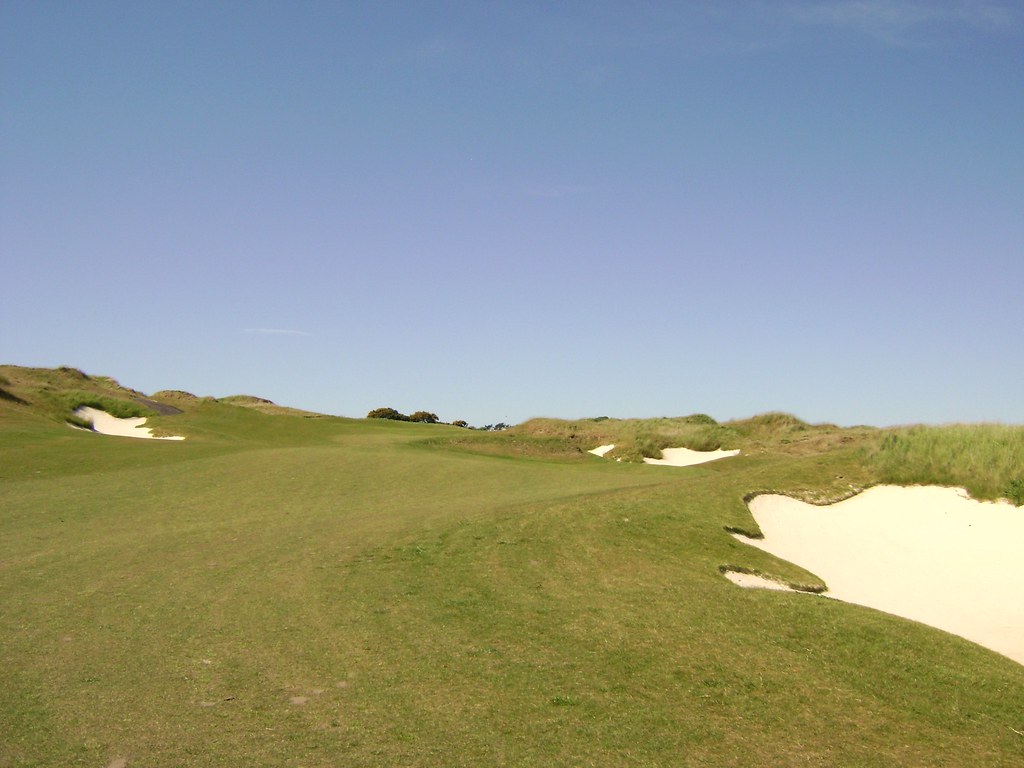
Switching course, the 12th plays to 454 yards (par 4) up to the highest point of the property. That nasty looking fairway bunker complex requires a carry of 210 yards (pray it’s downwind)
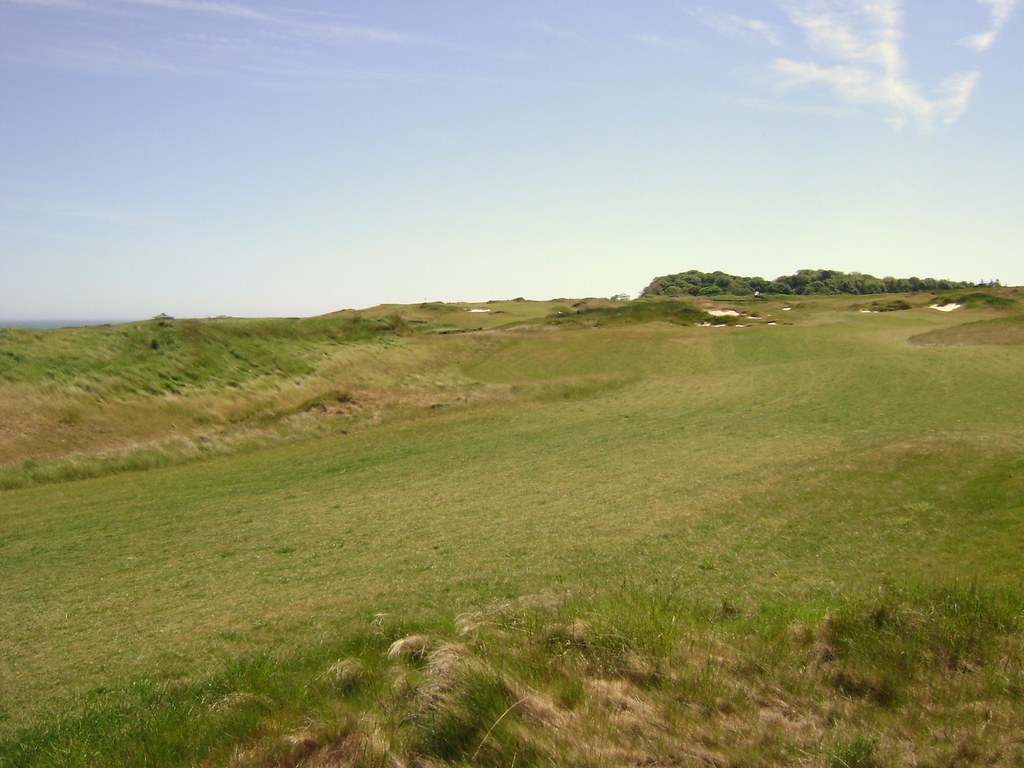
Into a headwind, a mortal probably won’t reach the green. A slight draw through a gap between bunkers at 130 yards from the green will flow with the right to left slope of the fairway to where the divots are seen ahead. From there, it is best not to miss left of the green…
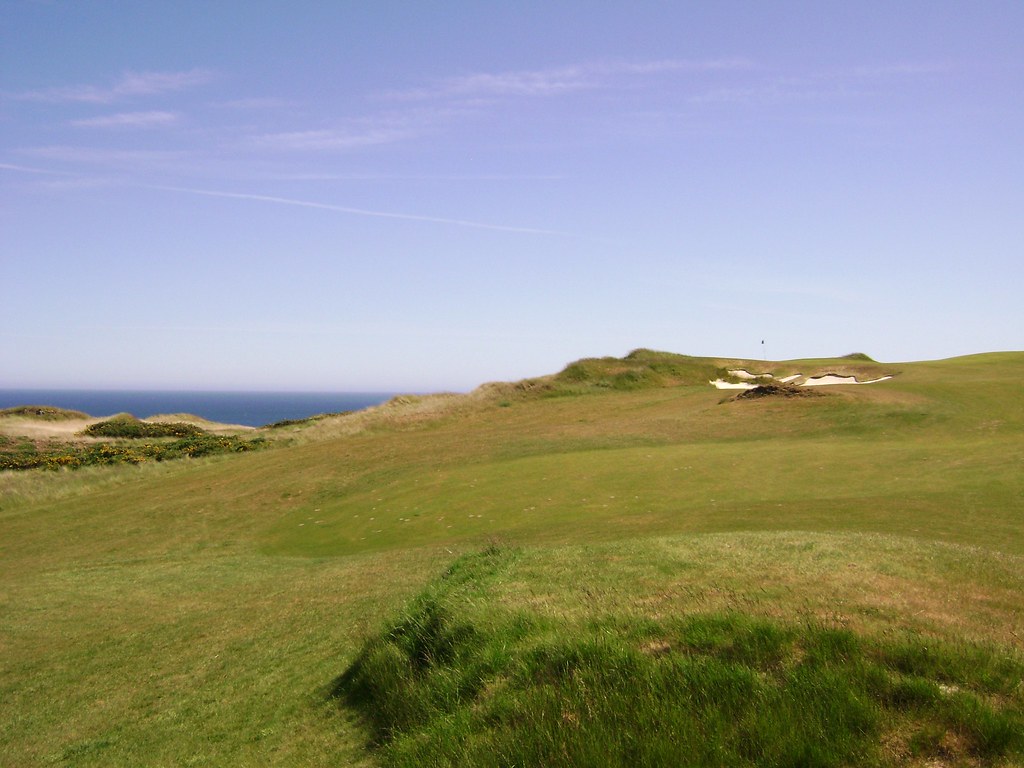
Looking left from the 12th green, one appreciates the amazing amount of shaping that occurred not only within but between holes to create a naturalistic setting. Are you convinced?

The 13th hole (179 yards) favors a fade played at the left edge of the green
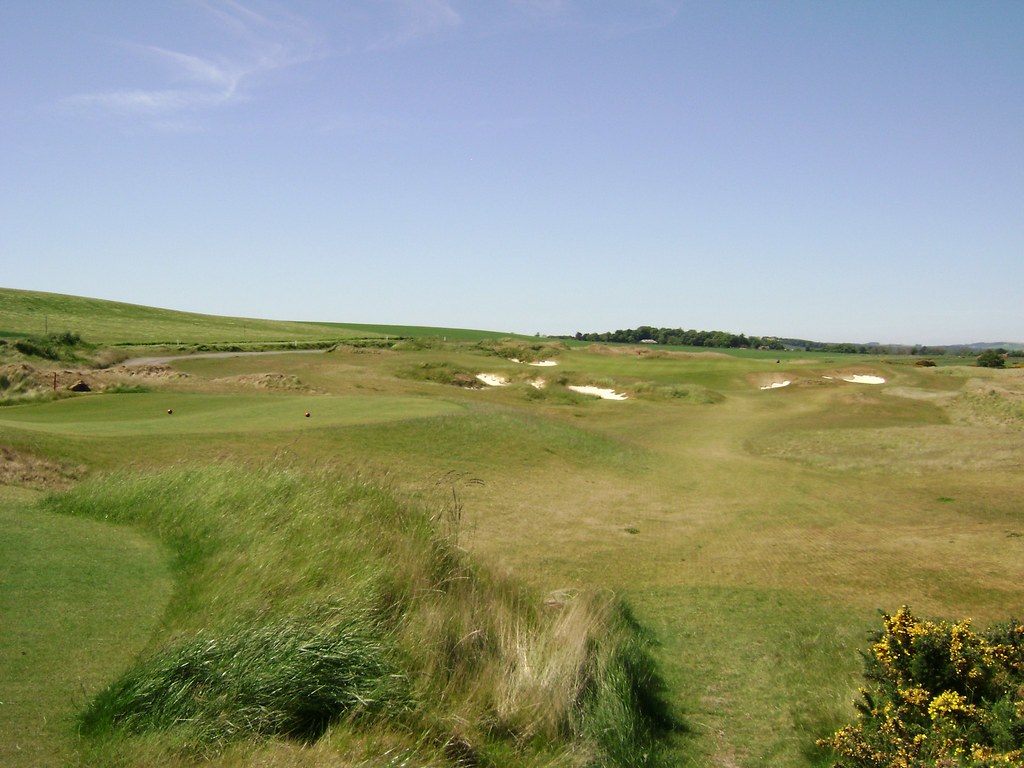
Looking back across the 13th green to the 12th.
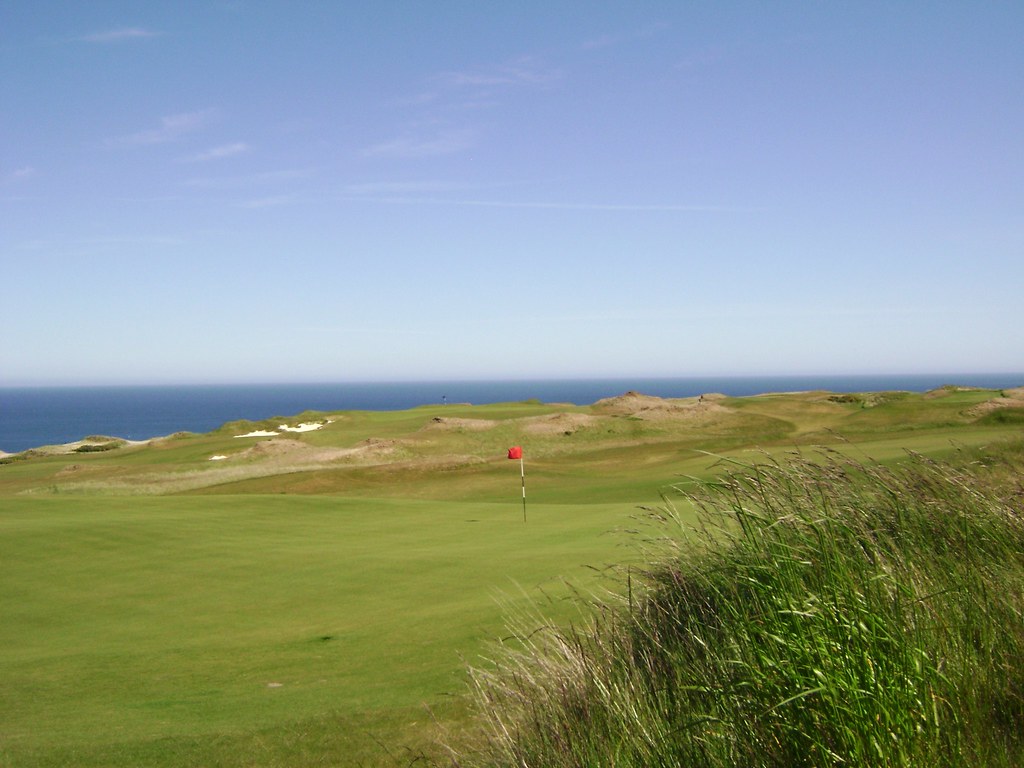
The 14th (400 yards) fairway snakes down and around a gorse-covered hill…
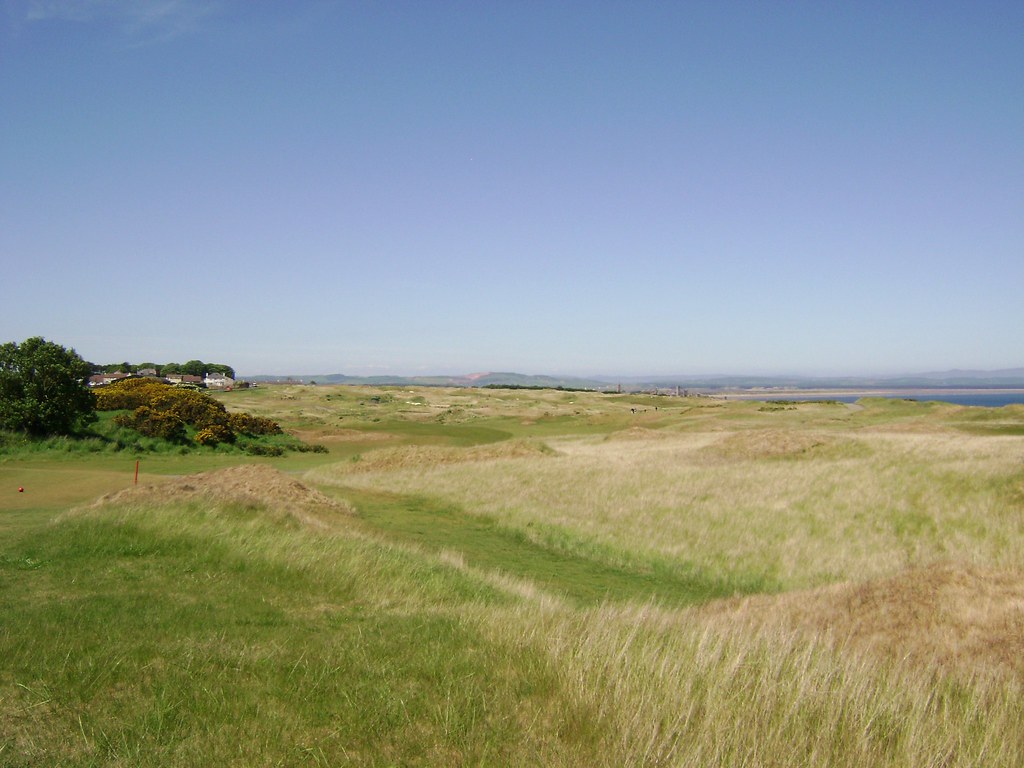
… before turning right and narrowing considerably around 80 yards from the green’s center.
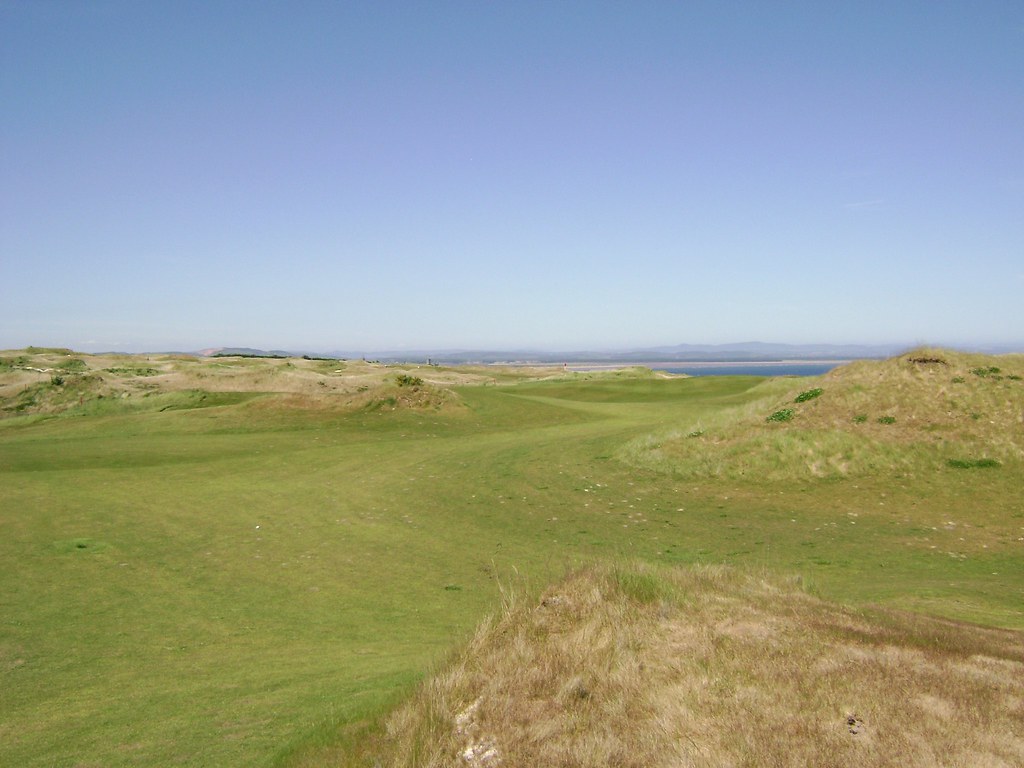
A look at the 14th green hints at its enormity along with the wild undulations found within and around it.

The 15th hole is a par 5 of 585 yards. A direct line to the flag requires a precise shot to the narrow left portion of the fairway.
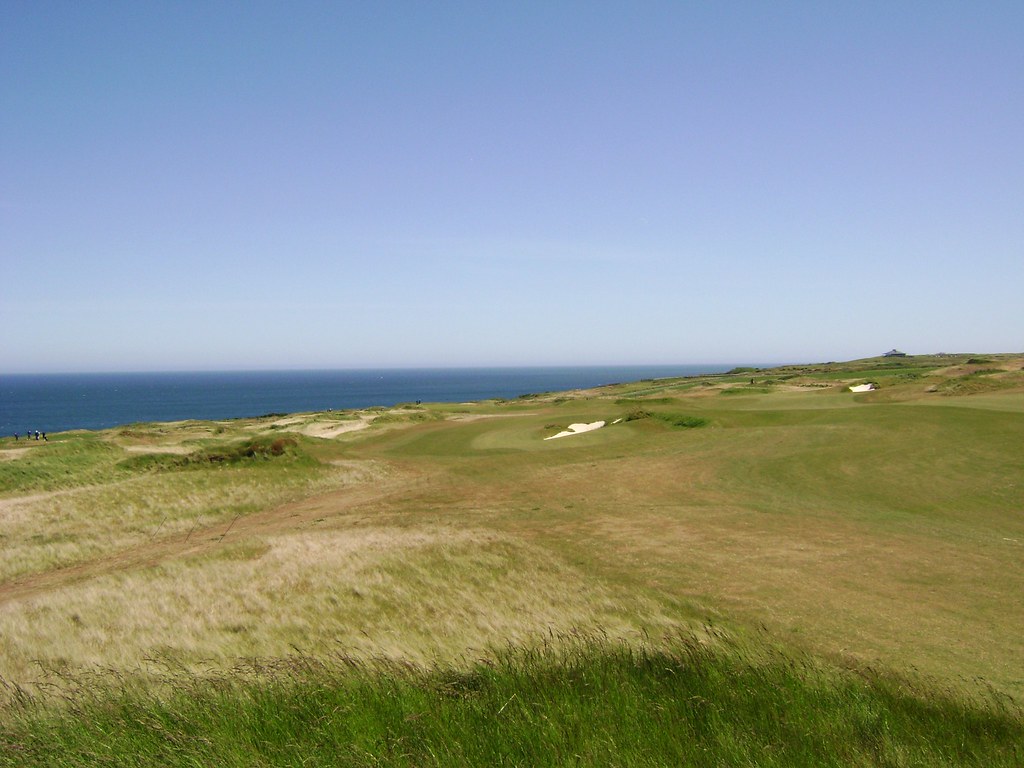
From the right, one sees the burn that protects the green from long, running approach shots.
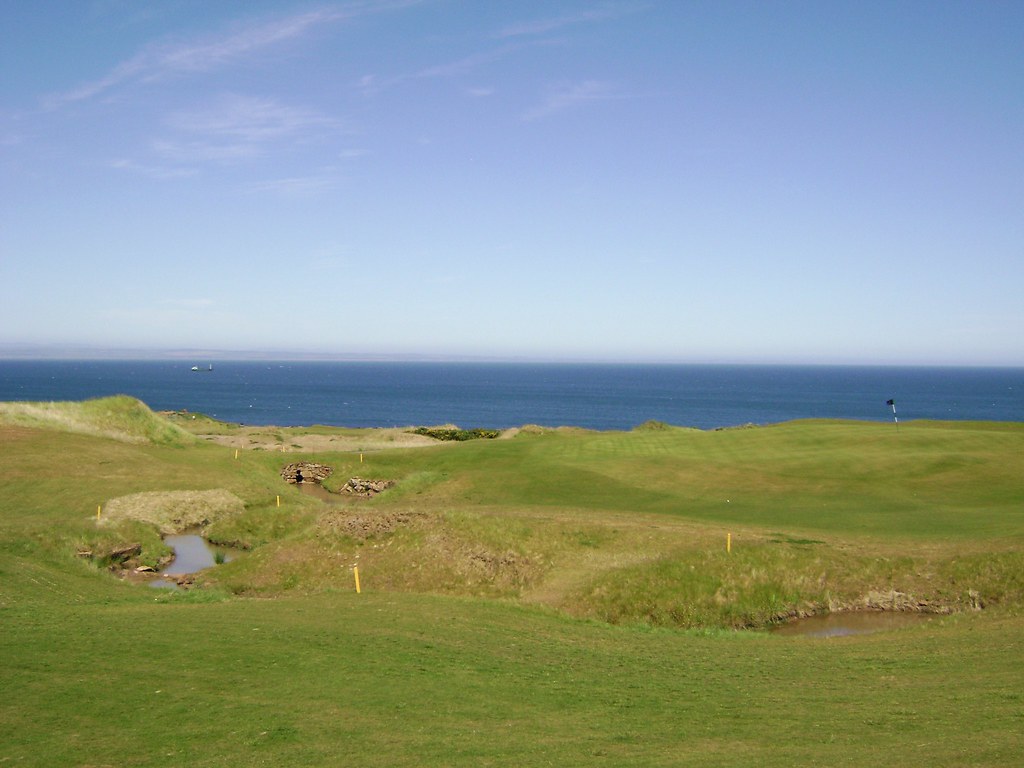
Playing to the southern end of the property, the 16th hole stretches to 406 yards. The left side fairway bunkers require a 210 yard carry to clear, but the ideal line is down the right side as the fairway feeds left.
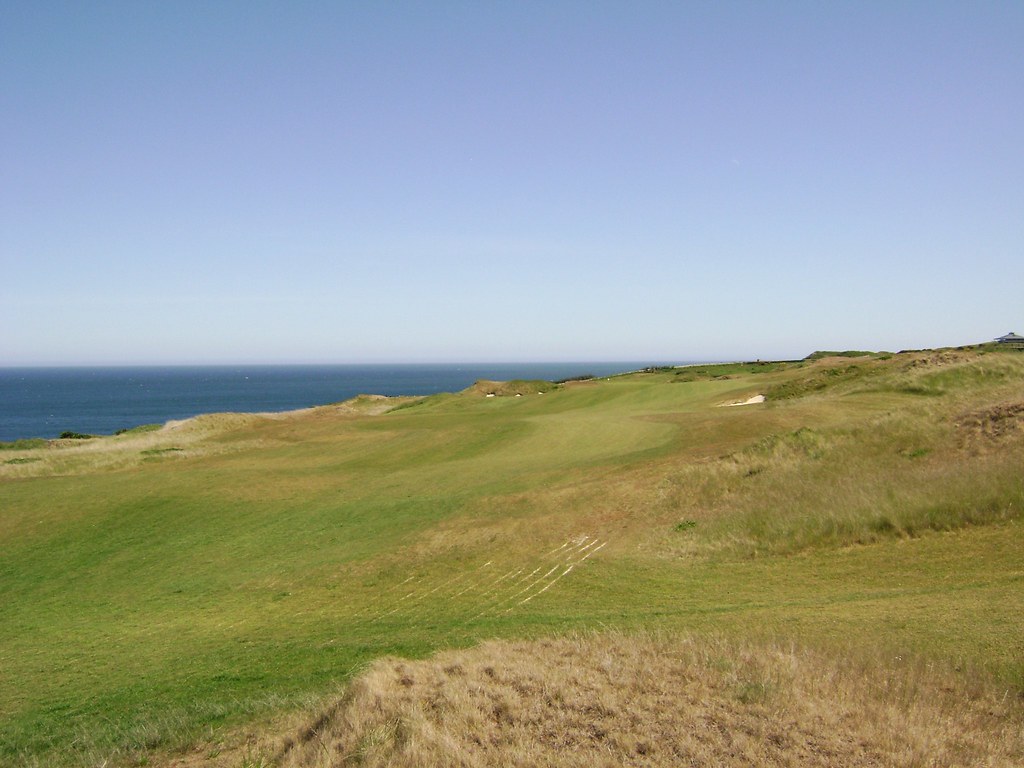
This centerline mound is 130 yards from the green and marks a mild left dogleg in the fairway. A deep swale and upslope front the green complex.
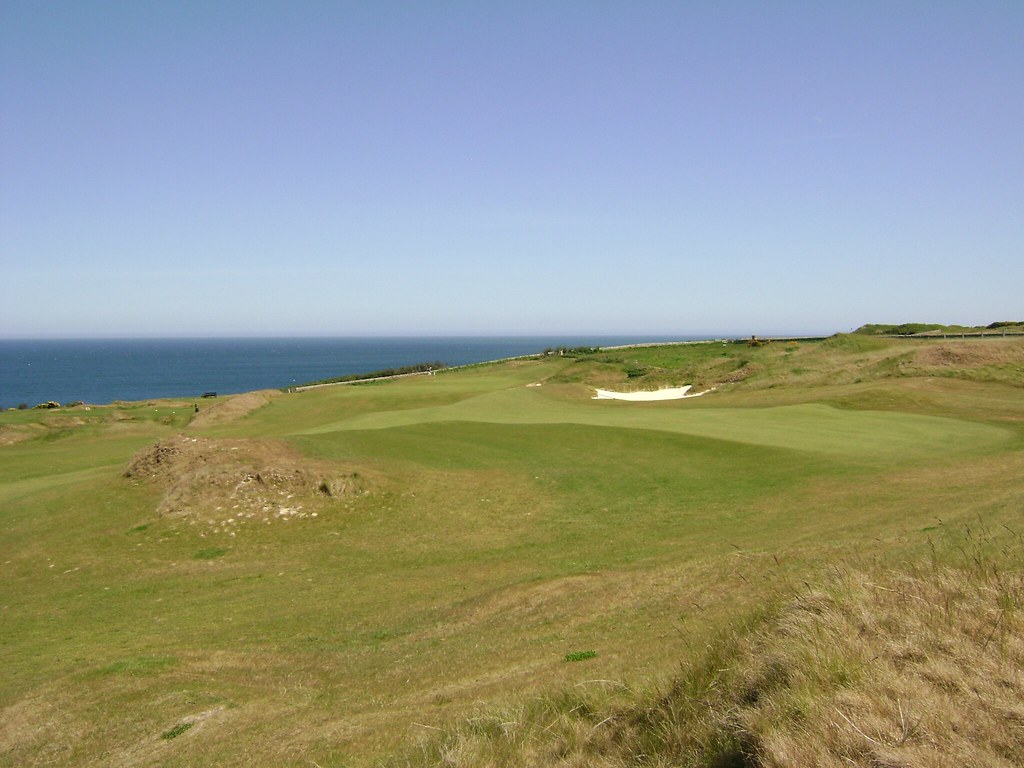
Looking back at the slopes in the fairway and tiers of the green.

An overview of the postcard, 184 yard 17th hole.
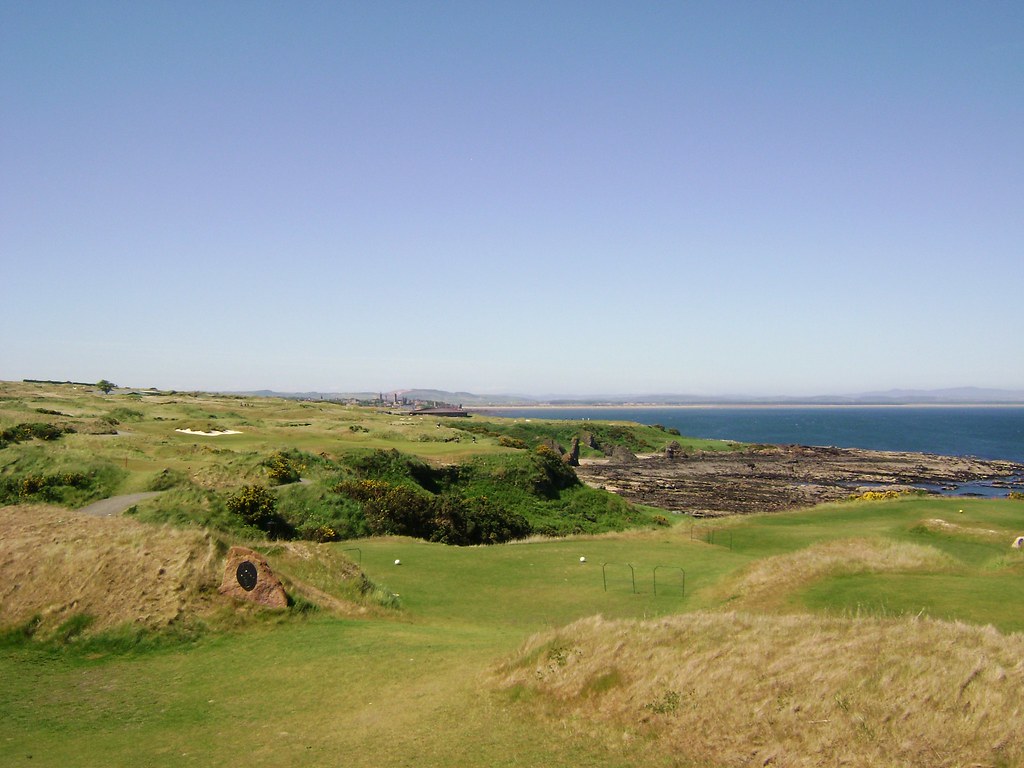
A closer view of the chasm from the walk to the green.
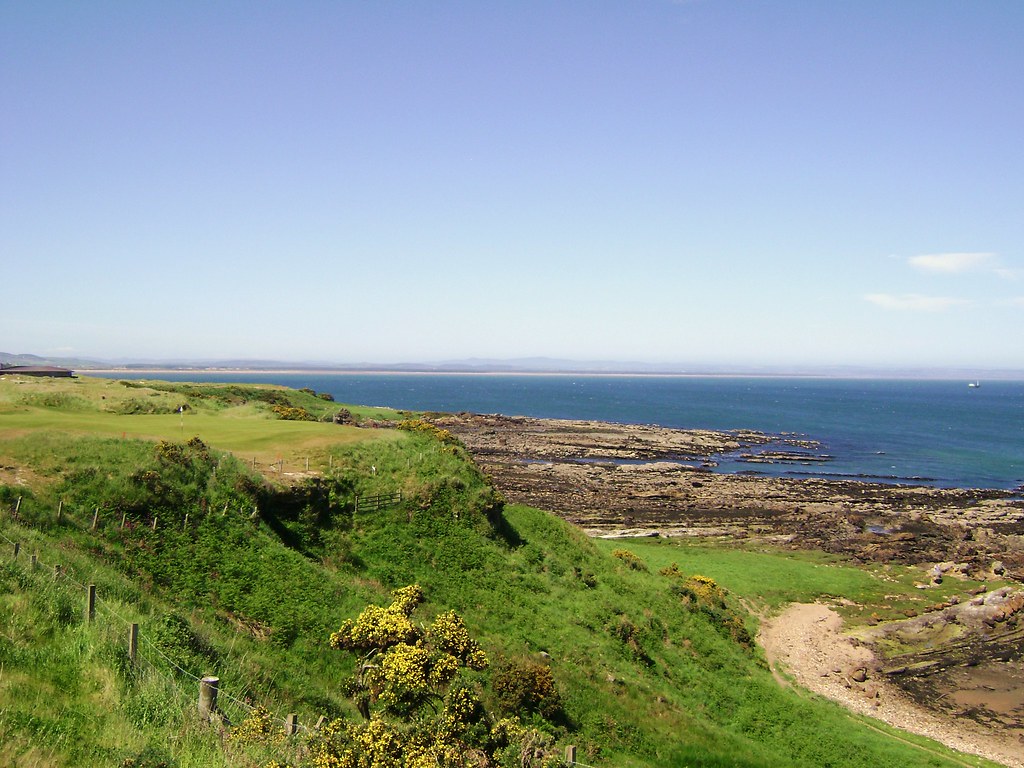
Looking from the high left side of the green to the low right side. The hole is best played as a reverse redan, especially downwind. Anything that attempts to fly onto the green can run through to a nasty bunker found long/right (you can’t see it because it’s perilously deep and at the cliffside).

The 18th fairway urges players away from the public coastal path along the cliffs
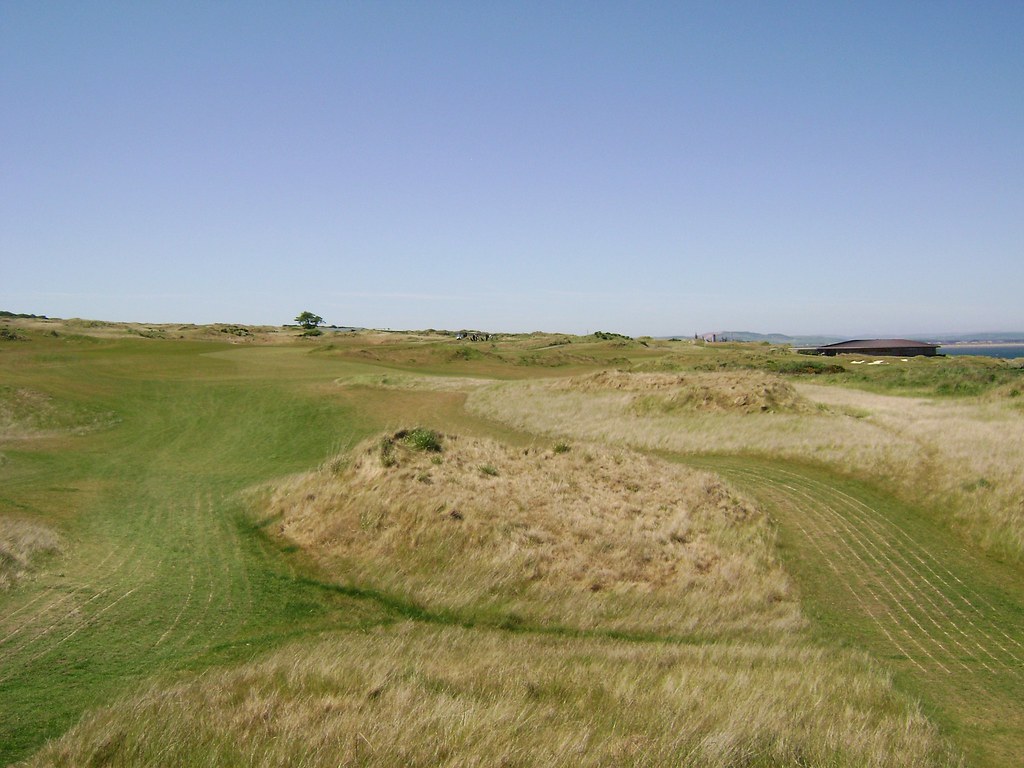
But a look to the right beckons players to shortcut the corner on this 555 yard par 5.
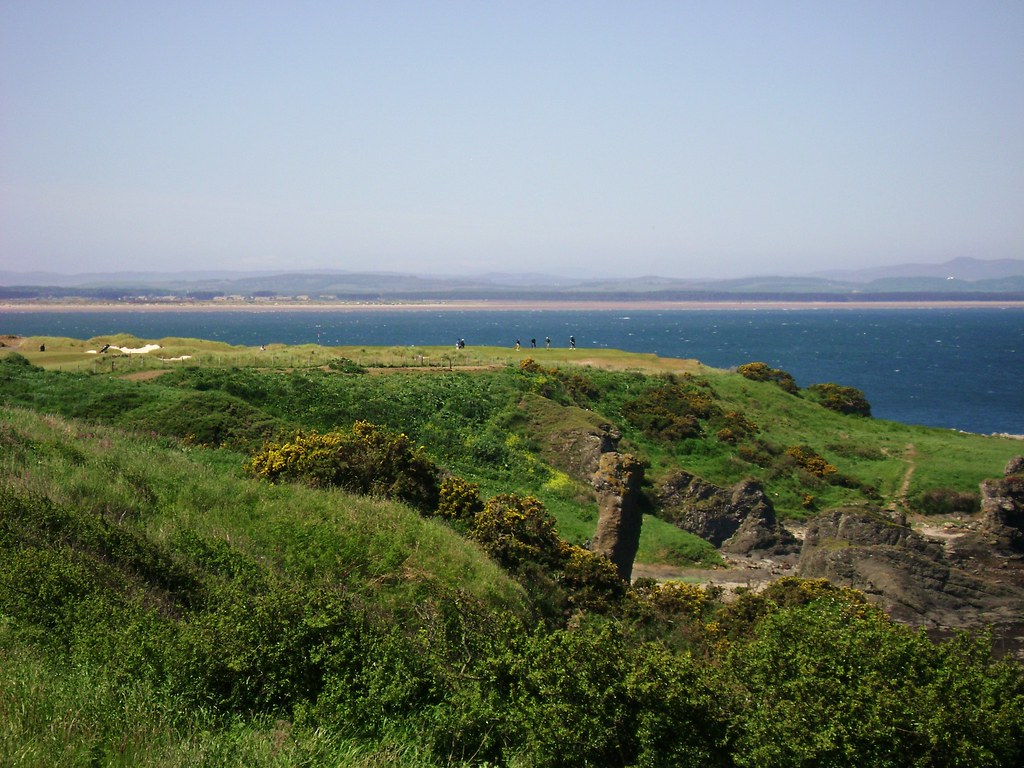
Looking back from the outside of the dog leg.

Looking forward from the inside of the dogleg. With a strong tailwind, I was able to drive just left of the nearest bunker, leaving 180 yard into the green. The prevailing wind is generally from the left rather than behind off of the tee.
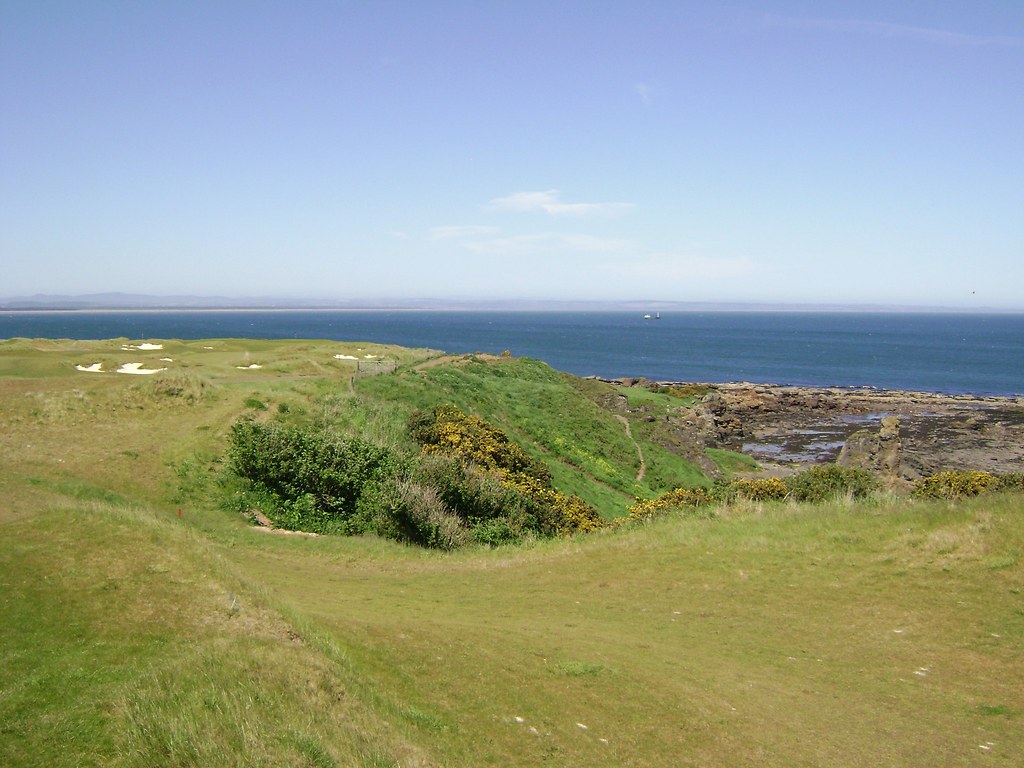
Lay-up shots must negotiate a centerline bunker 90 yards out.
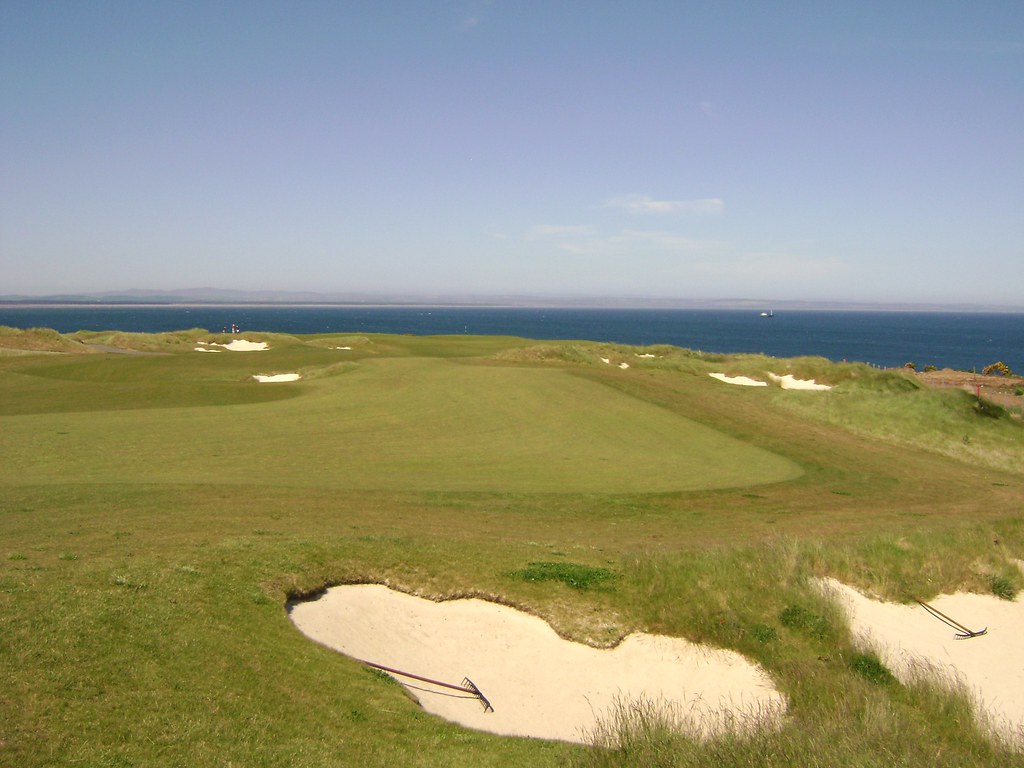
From left of the lay-up zone, the green is visibly open for low running approaches, but raised so as to reject tentative shots. Likewise, overaggressive play will result in the approach skipping over the back of the green where it may be lost forever.
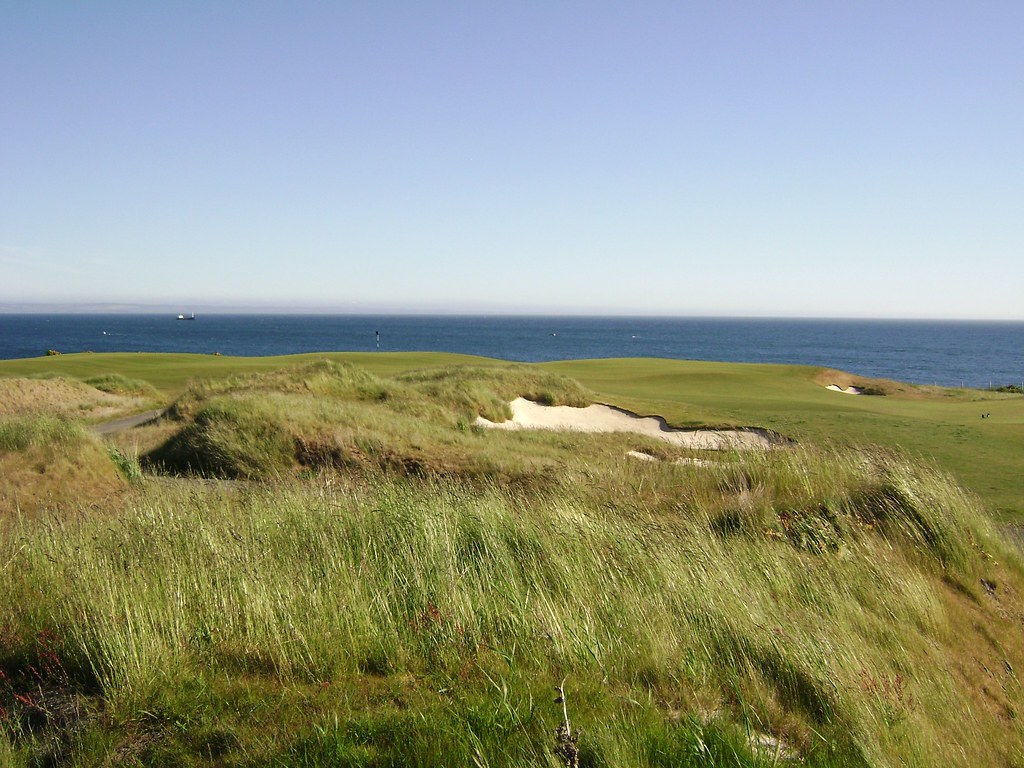
While many rightfully question the need for such a course and the expense of its construction, The Castle Course does provide compelling golf in a gorgeous setting of a variety not found elsewhere in Fife. It is a demanding test of golf, even in calm conditions, a characteristic that will alienate many golfers but probably also attract a dedicated following of individuals that appreciate its challenges.